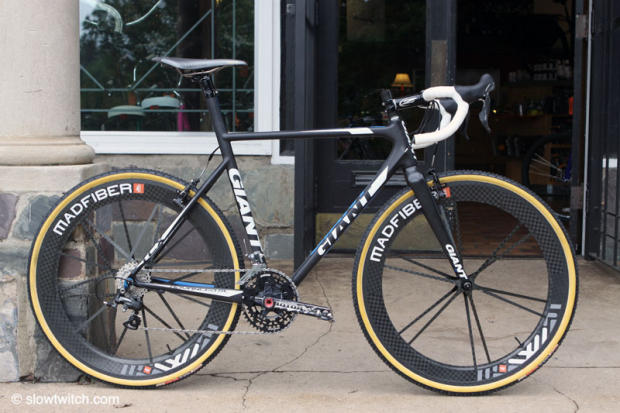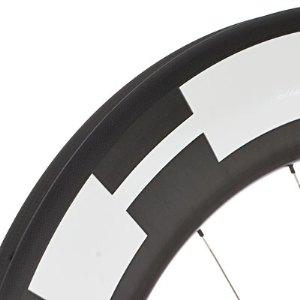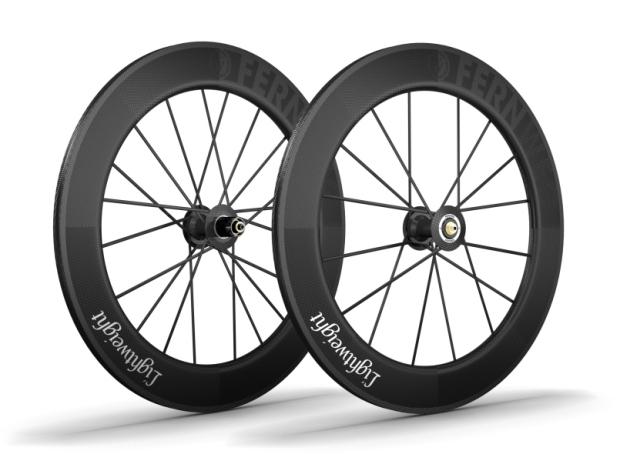Going on a Mad Fiber diet
Today we take a closer look at the ultra light Mad Fiber wheels, which we had in our hands for a long-term test and all the test bikes that had them mounted were seeing instant signs of a successful diet. During the 9-month period we had the wheels they were used on a cross bike and a road bike. We never used them on a tri bike, but Kiwi pros Cameron Brown and Joanna Lawn have been racing on them and did so also in Kona this year.
We had the wheels long enough actually that the wheels available for purchase have since been re-designed with a new axle and freehub. Now Mad Fiber has a proprietary design, while previously using one from White Industries. The new axles and freehub are aluminum and the Shimano edition is 11-speed compatible, plus the freehub bodies are now interchangeable among wheels. We had the older White Industries edition in our hands, but with the cassette mounted and the wheels on a bike that is not obvious.
Mad Fiber also provided us with a White Paper.
The first impression I had of the wheels was actually not a good one, but not in the sense you might expect. When the box arrived it was so light I was convinced that somehow I must have received only one wheel, and what good would one wheel do? But I quickly realized that both wheels with skewers and valve extenders were indeed present and boy they were light. Crazy light actually with a 434g front wheel and a 634g rear wheel. Before too long I was on my way to a local bike shop to get tubular tires mounted on these Mad Fiber wheels, and my trusted road bike as shown below weighed a stunning 13.2 pounds with them.
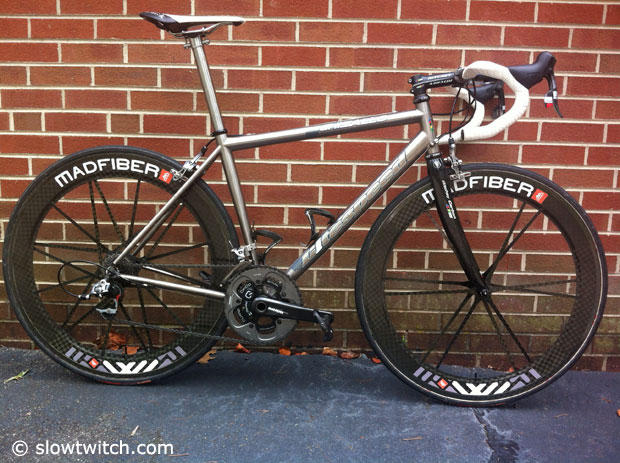
Because the folks at Mad Fiber had told me that using them on a cross bike would be perfectly fine, and I had just received a new cross bike, I decided to actually test that theory. Once that new Giant TCX Advanced SL was built up with Mad Fiber wheels, Challenge Grifo tires, Rotor cranks, Shimano Ultegra drivetrain, TRP brakes, Zipp cockpit, Fizik saddle and Shimano XTR pedals it tipped the scale right at 16 pounds and that is pretty darn light for a cross bike that fits a 6'2" guy.
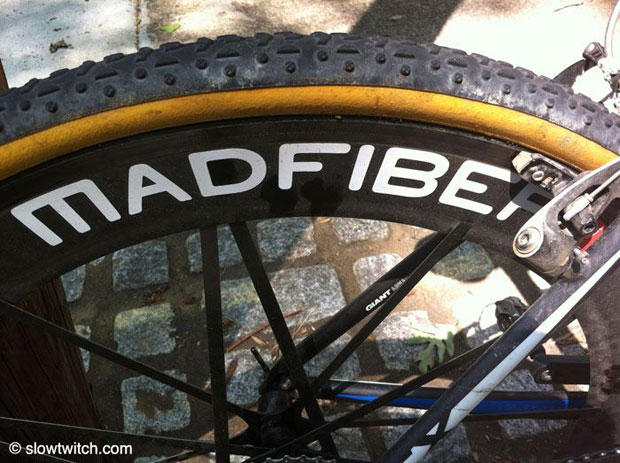
The shop mechanic who had built up the bike had been somewhat skeptical of the wheels, but he was the first one to take it out for a test ride and this seasoned cross racer came back to the shop with a smile on his face. He noted and liked the quick acceleration and noted that they were surprisingly stiff.
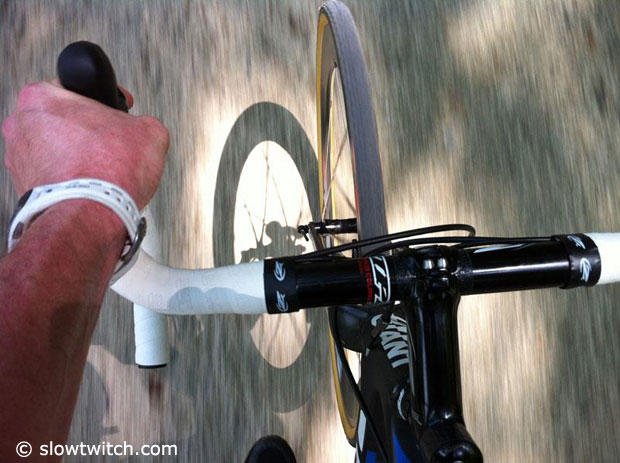
I then spent several months on them riding on various roads, trails, fields and some cases pretty tough technical terrain and they handled well. One day while crossing a large rock field I passed a few mountain bikers and they were surprised that this non suspended rider was cruising past them. If it had not been for the occasional carbon brake squeal I actually sometimes forgot that I wasn't riding a traditional wheel set. Plus of course when shouldering the bike was required, the light weight of the complete bike was very noticeable and greatly appreciated.
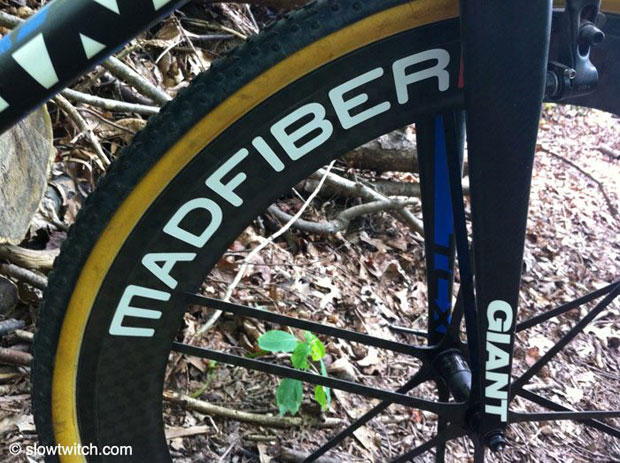
But more time with these Mad Fiber wheels was spent on the road with Challenge Triathlon tires mounted on them, and the trusted size ML Litespeed Ghisallo with a stock 2010 SRAM Red group, standard Look Keo pedals, Profile Design carbon cages and a Quarq power meter weighed in right at 13.2 pounds with the Mad Fiber diet. I felt even more confident on this setup but that is of course due that I know this bike very well. The giant TCX Advanced SL was new to me in every aspect, while this Litespeed has been in my hands for many years now with some slight modifications along the way. So that allowed me to focus on the only component that is indeed new and different. These wheels are very fast for sure and the rate of acceleration is impressive. I for one am not the type of rider who is overly concerned about having the stiffest ride, and thus I also had no issue with the Mad Fibers along those lines. But I did let other folks ride them who are a bit more anal in terms of "stiff is better," and they too had no issue, and if anything seemed positively surprised. Even under hard cornering the wheels are very steady and gave me a good sense of confidence. But you better go fast and with a bit of positive attitude when you ride wheels like these.
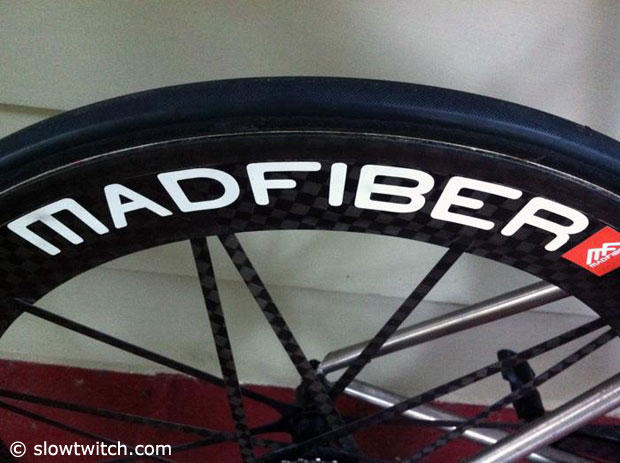
A closer look at the front hub of the Mad Fiber wheels and how the 12 bladed spokes up front attach to it.
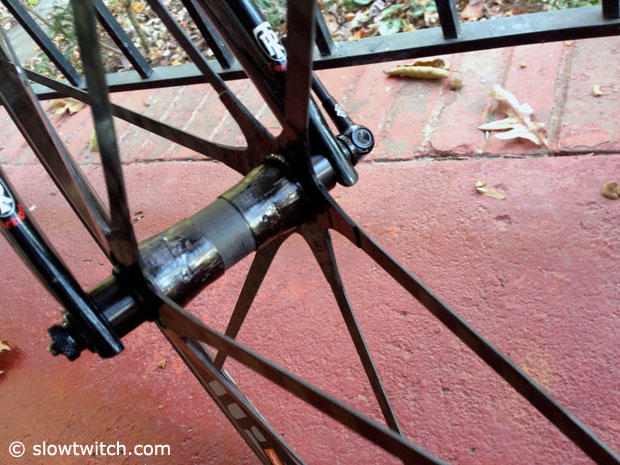
The rear hub is fairly beefy and the internals of the one we tested are from White Industries. The rear wheel features 18 spokes with 12 on one side a 6 on the other.
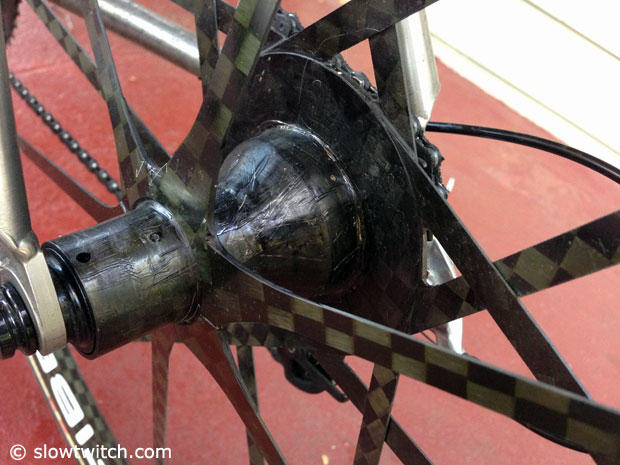
Six double spokes attach on the drive side, with six singles on the opposite side.
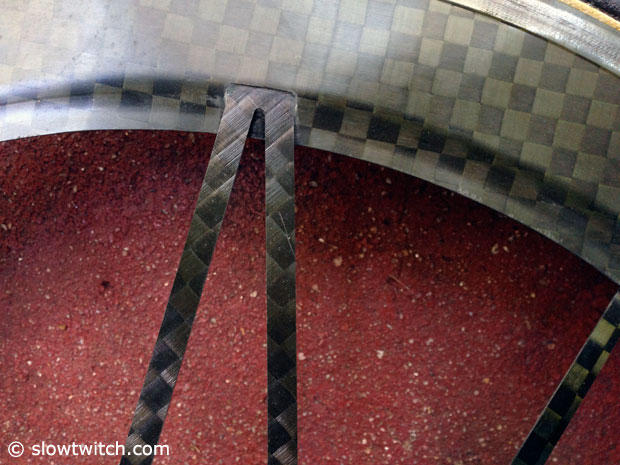
Twelve single spokes are up front.
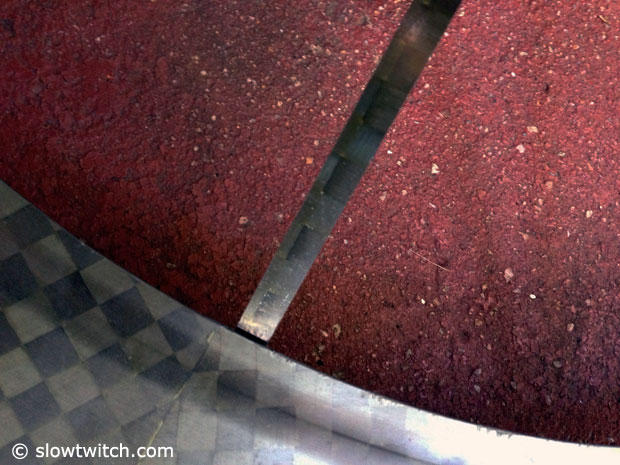
Our Mad Fiber front test wheel weighed 434 grams.

The rear was an equally impressive 634 grams.
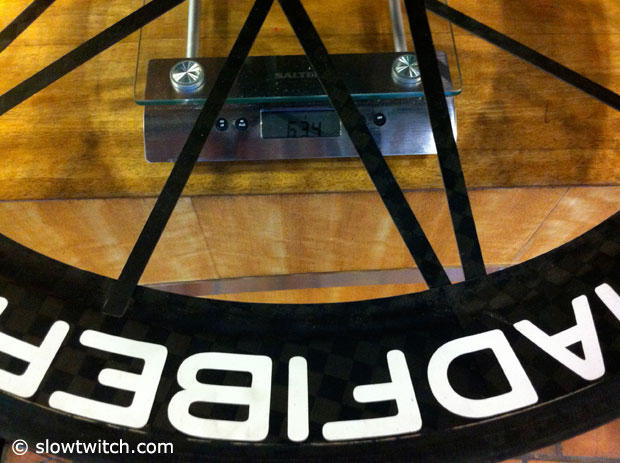
But what do you do if you break a spoke or crash these wheels? After all you can't just simply replace a spoke. Mad Fiber suggests that you call them and arrange an inspection of the wheel in question. They then repair, or offer a low-cost replacement through their crash replacement program.
The wheels certainly get attention with their unique profile and on several rides various other cyclists and in some cases even motorists have asked me about them. I would certainly recommend the wheels to anyone looking to take weight of their bike. There is no rider weight limit and they held up well during the testing period they were here. They do look a bit rough in terms of the finish, but there was nothing along those lines that really bothered me in particular.
A wind tunnel visit was not on the testing agenda so we can't talk about the drag numbers of the wheels, but the question of rim width is now a very common one and has come up. As manufacturers like HED and Zipp have pushed to brake track widths wider than 26mm and quite a few other brands such as Enve, Reynolds and Bontrager having followed in their tracks, there is now an increased demand for wider rims. Mad Fiber wheels are fairly standard 21mm wide and that of course allows them also to be ultra light, but a popular theory now is that wider is better. Not so much of an issue if you are planning to run an ultra narrow tire, but certainly as the tire size gets bigger the more of a light bulb effect is created on a narrower rim. Lightweight, another brand known for ultra light deep section carbon wheels has now ventured into the wider wheel market with their Fernweg wheel, but that wider section is closer to the spokes while the rim width at the brake track is still closer to a traditional wheel. So what we are really seeing here is that both these brands are focusing on being light and any aero benefit that happen to come with the wheel is appreciated but not really part of the design process, and that is certainly what Ric Hjertberg of Mad Fiber told us. But there is an interest in aerodynamics for sure. We listed a link to Mad Fiber's white paper above and they actually spent quite a bit of time discussing aerodynamics of their wheels.
These wheels though are meant to make your bike lighter and they certainly do that without an obvious penalty. Shedding a pound of weight of your body is less expensive, but doesn't help the rotational mass and clearly is not as much fun and makes bragging a bit more difficult. If you show up with these wheels at the next group ride or race you will certainly get quite a few looks and questions, but you better not get dropped on the first big climb. Because climbing is where these wheels really excel. It is truly a shame that there aren't as many long climbs close to Winston-Salem as I had access to when residing in Chattanooga, but there are plenty of places where I appreciate them very much including more level routes. I never raced these wheels in a cross race and while I think they would work well in that application, I think they are better suited for the road. Especially the one that goes uphill.
Mad Fiber wheels
MSRP: $2,899
Weight: 434g front, 634g rear (our measurement)
Brake Track Width (Center): 21mm
Spoke count: 12 front, 18 rear
Rider Weight Limit: none


